The last and very important step in drum mixing is to add reverb to the drums. Reverb will give your drums air, and space and make the sound more natural.
Reverb is a very important tool in mixing. It makes your songs more natural-sounding, spacious, and bigger. You can use reverb not only on drums but also on vocals, guitars, keyboards, etc.
But drums require a little different approach when it comes to reverb. Also, the way you add reverb on drums depends on what type of drums you use.
Acoustic drums may require a different approach. You can add no reverb at all and use the room sound for the reverb effect. But with VST drums, you need to use some reverb plugins to make your drums natural.
In this tutorial, you will learn what is the best way to add reverb on VST drums. That’s because most home recording studios use drum plugins to record drum tracks.
How To Add Reverb To Drums
Reverb is very important for drums. You must use it correctly on drums. If you don’t, your drum sound will not be good and it will spoil your whole mix.
There are various ways to apply reverb on VST drums. It depends on personal taste and preferences. But there is a good practice that works in every case.
This drum reverb guide is for VST drums only. This method is great for home recording. Real drums need different approaches and methods. I use Reaper as my DAW for this tutorial.
1. Record Drums
The first step before you use reverb on drums is to record your drums. You can record VST drums in two ways. One way is to use a MIDI controller and play drums on the keys. The second way is to program drums with a MIDI sequencer.
Playing drums on the MIDI keyboard will sound more natural because of the velocity difference. But then you have to quantize it to be on time. It may take some time.
If you program it manually, the timing will be perfect but then you have to adjust the velocity for each note. It’s also time-consuming. Choose your preferred method and record your drums.
2. Mix Your Drums
The next step is drum mixing which is a very important step. The quality of your drum sounds heavy depends on the mixing. If a drum mix sounds bad, it will sound worse with reverb.
The first thing you need to do is to separate every drum track and send them to individual tracks.
Your kick, snare, hi-hat, toms, and cymbals should have their own tracks. Modern VST drum plugins allow you to create separate tracks for every drum kit.

Then mix the individual tracks with EQ and compressor. After you are satisfied, create a drum bus track and send mixed drum tracks to this bus track. This will be your main drum track.
3. Create A Reverb Track
You have your drum sound. You mixed it and created a drum bus that is your main drum track. Now it’s time to add reverb on drums. And you have to do it properly. Otherwise, your drum will sound not so good.
There is a special way to apply reverb to drums. Many beginners make mistakes when they add reverb on an individual or the main drum track. You can do it but the sound will not be as good and many issues will occur.
So, you need to create an environment where you have your main, dry drum sound but also some way you need to add reverb. What you need to do is create a new track with just a reverb plugin on it.

Now you have two tracks to work with. One is your mixed drum bus track where you have sent kick, snare, toms, etc. And a new track with only reverb plugins on it. This way you can control your drums and reverb separately.
If you add reverb on individual drum tracks like a bass drum, snare, and so on, every reverb will have different settings. This will cause problems because it will not be cohesive. But if you apply reverb on your main drum bus, then you lose control of it.
4. Send Drum Tracks To Reverb
To apply reverb on drums you need to send your drum signal to that reverb track. And the best way to do it is to send the individual tracks of your drums. It will give you more control of your sound.
Like you have sent your individual drum tracks to the drum bus and sent the same tracks to the reverb track. Now you have individual tracks that are connected to the drum bus and also to the reverb track.
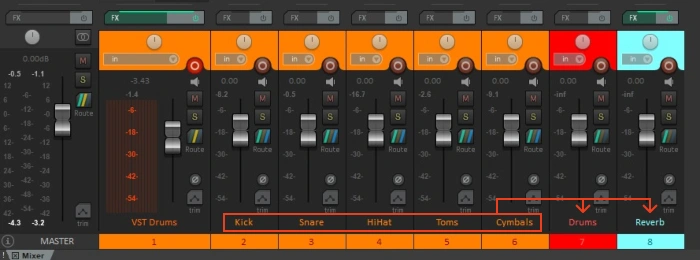
But remember that not every track goes to the master bus. Individual tracks go to drum bus and reverb track. These two tracks go to the master bus, not individual tracks.
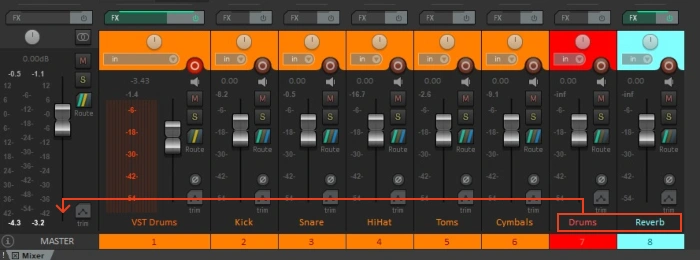
Now, to start applying reverb, the first thing to do is to set your reverb settings to the default. This way you will hear how each track sounds with the default reverb on it. Just send every track to the reverb bus and set its settings to default.
In general, not every drum track needs a reverb. For example, you can omit a kick drum from the reverb. You can have a dry kick drum. Sometimes a low-end causes issues. But because you have separate tracks, you can send everything to the reverb track and adjust them later.
5. Adjust Individual Track Volume
You have a default reverb with all the drum tracks connected to it. To apply reverb on drums properly, solo this track and start listening to it. Listen to how each instrument sounds and also how your drums sound on the whole.
After you get used to the sound, you will find that not every track needs the same amount of reverb. For example, the snare may sound good but the kick drum could have too much reverb.
You can adjust the volume of the sent signal. Every modern DAW has the option to choose the volume of the sent signal. So, depending on your preferences, start to adjust volumes for each track.

For example, if you think that reverb is too much for a kick drum, just lower the kick drum volume. It still is there, but because of the low volume, the reverb effect won’t be too much.
But don’t lower the actual kick drum track volume. It will ruin your sound. Just lower the volume of the sent signal. You can read more about pre and post-faders here.
6. Create The Reverb Sound
After you adjust everything it’s time to create a reverb sound. To use reverb on drums of course you need a good-sounding reverb. But it all depends on your song and your personal preferences.
While your reverb track is in solo, start adjusting different reverb settings and create the sound you like. You may want to have a big, spacious sound, or a room reverb sound. It depends on you.
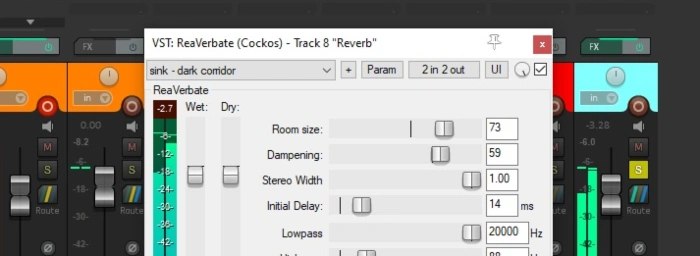
Of course, it’s better if you already have some ideas on how you want your drum reverb to sound. It will make your job much easier.
For great-sounding drums, you can use a trick. While you are adjusting the reverb in solo try to hear it with the main drum track after some changes. Listen to how they sound together. The goal is to create one big, natural drum sound.
Continue until you find the best sound for your drum reverb. Create in solo but check it with the main drum track in between. After you finish creating a reverb sound, it’s time for the final step.
7. Blend Drum Reverb With Drum Bus
The last step of how to use reverb on drums guide is blending two sounds together. This is the easiest task to do but there are some specific steps you should follow.
The goal of blending two sounds is to have your punchy, powerful drum sound with some space and air. The main power comes from your drum bus and the breathing air comes from the reverb.
You can do blending in two ways. You can just solo your drum and reverb tracks and blend that way. Or just play the whole mix and blend while listening to the whole mix. The second way is better.
This is how you blend drums and reverb. Turn off the reverb track completely by lowering the fader. So, now you are listening to the whole mix without the reverb track.
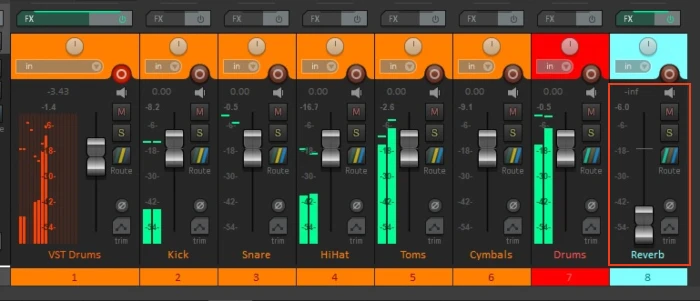
And while you are listening to it, start moving up the reverb track fader. As you do it, soon you will hear some reverb. Continue it until you start hearing the reverb clearly.
You have to balance the blending based on your preferences. But the reverb sound must not be louder than the drum track. It should blend and add the reverb effect to it. You have to find the best spot where it sounds great.
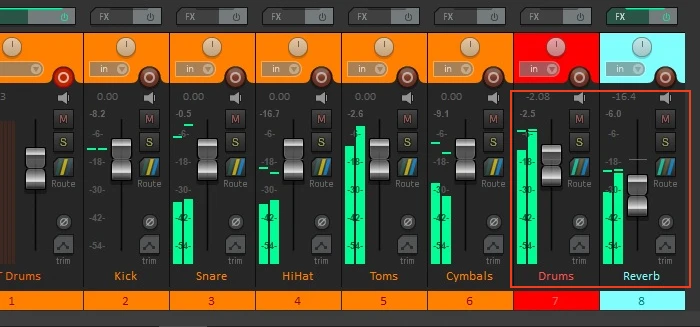
You can solo both tracks and you will hear the effect more clearly. Continue doing it solo or with the whole mix until you are satisfied with the sound. There are no rules. Every song needs a different approach.
The goal here is to maintain the power of the main drum track but also blend some reverb. The sound mustn’t be too dry or too wet. Continue blending until it sounds as you want.
Conclusion
This is one of the many ways you can use reverb on drums. There are various ways to do it. But this method works in most cases. No matter what genre it is. This is the best practice to add reverb on VST drums.
You can tweak some settings or change some little things here and there. But follow the core steps and your drum will sound powerful and big. At the same time, it will have to breathe air and natural sound.
